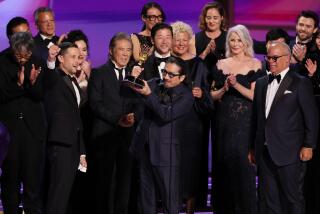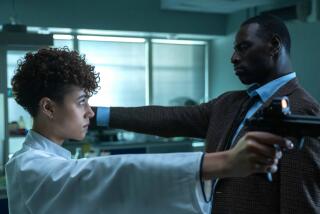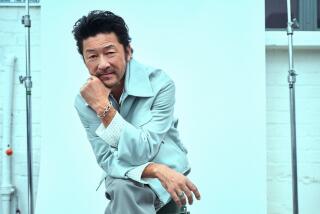Indie Focus: Takashi Miike picks up a genre’s sword for ’13 Assassins’
- Share via
In the waning days of Japan’s feudal era, an army marches into a village and is ambushed by a small band of samurai determined to topple the merciless lord leading the much larger force. As “13 Assassins” moves toward its dazzling, dizzyingly over-the-top climactic battle sequence, it gains a momentum of startling inevitability, as if these events simply must come to pass. The lengthy frenzy of blood, mud, arrows, swordplay and honor righteously defended that ensues is furious, intense and unrelenting.
Takashi Miike’s first take on Japan’s venerable samurai genre, “13 Assassins” is a remake of Eiichi Kudo’s 1963 movie of the same name and adheres with an unexpected faithfulness to the story and structure of the original.
Miike, 50, an outlandishly prolific filmmaker credited with more than 80 films since the early 1990s, has become a fixture of the international festival circuit and is known to American audiences for the flamboyant visual style and subversive humor of such genre-hopping films as 1999’s “Audition,” 2001’s “Ichi the Killer” and 2007’s “Sukiyaki Western Django.”
In “13 Assassins,” which opens Friday in Los Angeles and is already available on video-on-demand, he surprises by playing the action with a straight face. But Miike still finds a way to include idiosyncratic imagery, such as a haunting look upon a woman who has been mercilessly disfigured by the film’s villain or the odd humor of flaming cattle rampaging through the village’s narrow streets.
The young feudal lord (played by Japanese pop star and actor Goro Inagaki) brandishes his power to rape and kill with impunity. With the ways of the samurai on the wane and many onetime warriors reduced to serving as government functionaries, an aging samurai (popular actor Koji Yakusho) assembles a small band of fighters to avenge one of the lord’s victims. In a way, they are following the code of the samurai to bring an end to the era of the samurai, hoping for one last heroic battle in which to die with honor.
Much as many U.S. directors might harbor a not-so-secret desire to make a western, with that genre a means to explore the American psyche and national expansion, Miike noted that the samurai movie occupies a similar space for Japanese filmmakers.
“I would say westerns and samurai films are similar,” said Miike, speaking by phone from Tokyo. “What is similar is a sense of older values, and I think how we often have a desire to hold onto these values. And like westerns the audience is mainly male; men who want to see the kind of men they want to be, strong and living up to expectations.”
Though there are many parallels between samurai films and westerns — portraying a violent, honor-bound world of male-oriented aggression — there are key distinctions.
“There are a lot of similarities, in terms of the genre and the place the genre has, but the western is so about the lone individual taking a stand, and samurai movies only exist in a social context,” said Grady Hendrix, a co-founder and co-director of the New York Asian Film Festival, which has shown numerous Miike films over the years. “The western is about the West; it’s big, and it’s unlimited. Samurai, that’s a job title. It’s like a salaryman movie; it’s middle management with a sword instead of a suit.
“Certainly in Japanese cinema the samurai film looms large, kind of like the western does in the sense it is a really hidebound, stilted, rule-heavy genre,” Hendrix added. “I think a lot of directors view it as a challenge to see what they can do within those limitations.”
Miike was only 3 when the original “13 Assassins” was released. He had never seen it until approached by producers about two years ago with the idea of a remake. Though the samurai film, like the western, comes in and out of fashion, Miike noted there has been a resurgence of interest lately.
Many recent samurai films, Miike contends, have been “made for what a modern audience wants. So this means part of the story is taking the connections between modern-day men and women and putting them into a historical context, a modern-day love story shown in the past.
“Of course, our movie is not that kind of story. We try to look at what life was really like 200 years ago. ’13 Assassins’ is sort of more true to what a samurai movie really is.”
After avoiding the genre for so long, Miike has already taken on a second samurai picture: “Hara-kiri: Death of a Samurai,” his remake of Masaki Kobayashi’s 1962 classic, “Harakiri,” will premiere next month at the Cannes Film Festival in a prestigious slot in the main competition and is his first work in 3-D.
Despite the recent boomlet of samurai films, Miike said one of the biggest challenges was that many of the technicians and behind-the-scenes craftspeople who used to make such movies are no longer working; even getting enough horses for bigger scenes can be difficult. In a way, he added, “13 Assassins” turned out to be a history lesson both on and off screen.
The film, he said, was a vehicle to “teach the next generation of filmmakers how to make this movie and not lose this art.”
More to Read
The biggest entertainment stories
Get our big stories about Hollywood, film, television, music, arts, culture and more right in your inbox as soon as they publish.
You may occasionally receive promotional content from the Los Angeles Times.











